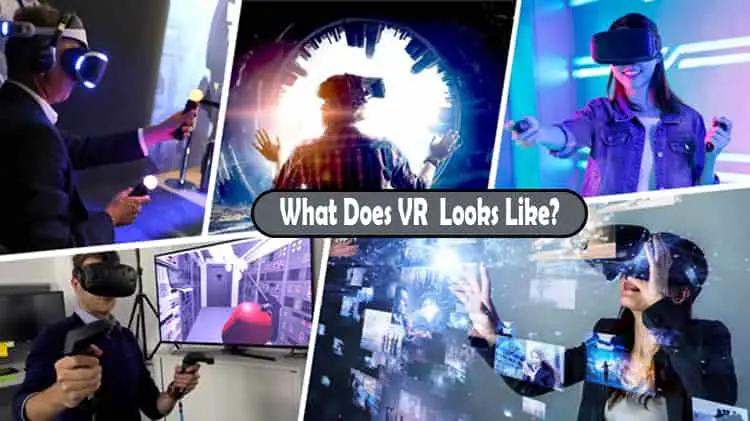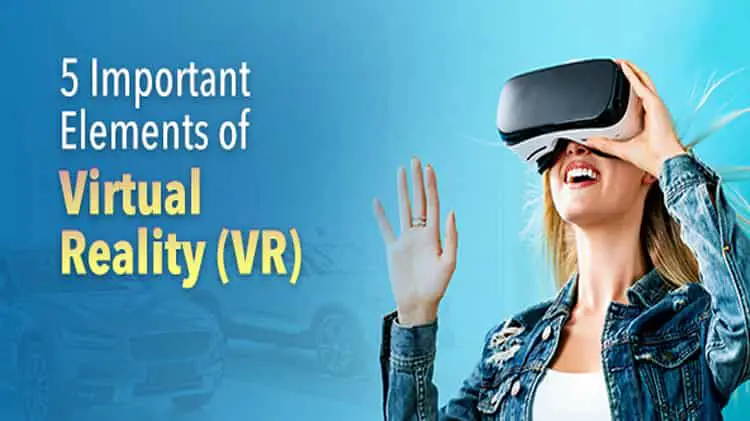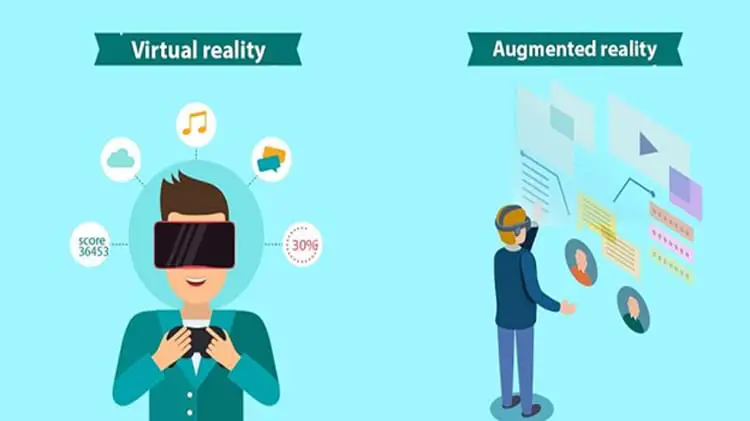Virtual reality is a game-changer in the world of technology. This article will explore what virtual reality looks like and how it is changing the way we experience the world around us.
Virtual reality has been around for several years, but it’s only recently become mainstream. It’s a technology that allows users to immerse themselves in a simulated environment and interact with it in a way that feels real. But what does virtual reality look like, and how does it work?
In this article, we’ll explore the various components of virtual reality, including hardware and software, and examine some of the ways this technology is changing the world. From entertainment to healthcare, virtual reality is revolutionizing the way we experience the world around us.

What Does Virtual Reality Look Like? Exploring the Components of VR
01. Hardware
The hardware used in virtual reality varies depending on the application. Some systems require a high-powered computer, while others rely on a Smartphone or standalone device. The most common types of virtual reality hardware include:
- Headsets: The headset is the most critical component of virtual reality. It is a device that you wear over your eyes and ears, which immerses you in the virtual world. There are several types of headsets, including tethered, standalone, and mobile.
- Controllers: Controllers are used to interact with the virtual environment. They allow you to move around and manipulate objects within the virtual world.
- Sensors: Sensors are used to track your movements and translate them into the virtual world. They’re usually placed around the room or attached to the headset.
02. Software
The software used in virtual reality is just as crucial as the hardware. It’s what creates the virtual environment and allows you to interact with it. Some of the most common types of virtual reality software include:
- Games: Virtual reality games are some of the most popular applications of this technology. They allow you to immerse yourself in a virtual world and interact with it in ways that aren’t possible in the real world.
- Training Simulators: Virtual reality is also used for training purposes. For example, pilots can use virtual reality simulators to practice flying without the risk of crashing a real plane.
- Medical Applications: Virtual reality is being used to treat a wide range of medical conditions, from phobias to chronic pain.
What Does Virtual Reality Look Like in Practice?
01. Entertainment
Virtual reality is changing the entertainment industry in a significant way. It allows users to immerse themselves in a movie or video game in a way that feels like they’re part of the action. Some of the most popular virtual reality entertainment applications include:
- Video Games: Virtual reality gaming is one of the most popular applications of this technology. It allows users to experience video games in a way that feels more immersive than playing on a traditional screen.
- Movies: Virtual reality movies are also becoming more popular. They allow users to feel like they’re part of the movie and can experience it in a way that feels more real.
- Theme Parks: Theme parks are also starting to incorporate virtual reality into their rides and attractions. This technology allows visitors to experience rides in a way that feels more immersive than traditional rides.
02. Education
Virtual reality is also changing the way we learn. It allows students to experience things that aren’t possible in the real world, making learning more engaging and memorable. Some of the most popular virtual reality education applications include:
- Field Trips: Virtual reality allows students to take virtual field trips to places they wouldn’t be able to visit in real life.
- Science Education: Virtual reality is being used to teach science in a more engaging way. For example, students can experience what it’s like to explore the inside of a cell or journey through the human body.
- Cultural Immersion: Virtual reality is also being used to teach students about different cultures. Students can experience what it’s like to be in a different country or learn about historical events in a more immersive way.
03. Healthcare
Virtual reality is changing the healthcare industry in significant ways. It’s being used to treat a wide range of medical conditions and provide patients with a more immersive and engaging experience. Some of the most popular virtual reality healthcare applications include:
- Pain Management: Virtual reality is being used to manage chronic pain without the use of medication. Patients can immerse themselves in a calming environment and distract themselves from their pain.
- Therapy: Virtual reality is being used to treat a wide range of mental health conditions, including anxiety disorders and PTSD.
- Medical Training: Virtual reality is being used to train medical professionals in a more engaging way. Surgeons can practice procedures without the risk of harming a patient.
Five Important Elements of Virtual Reality (VR)
Virtual Reality (VR) has been making waves in recent years, with its ability to transport users to a completely immersive digital world. But what makes VR so effective? In this article, we will explore the 5 most important elements of Virtual Reality that contribute to its success.

01. Immersion
Immersion is one of the most critical elements of VR. The primary goal of VR is to create a sense of presence that mimics the real world, and immersion is the key to achieving this. The more immersed a user is in a VR environment, the more likely they are to forget that they are in a digital world.
- Visual Immersion: Visual immersion is achieved by using high-quality graphics and realistic textures to create a visually stunning environment. The use of 3D models and photorealistic textures help to create an environment that is similar to the real world, making it easier for users to feel immersed in the virtual environment.
- Audio Immersion: Audio immersion is equally as important as visual immersion. It helps to create a sense of presence by providing realistic and spatial audio cues. This makes it easier for users to locate objects and other users in the VR environment, which further enhances the sense of presence.
02. Interactivity
Interactivity is another critical element of VR. Interactivity allows users to interact with the environment and objects in the virtual world, creating a sense of agency. The more interactive the VR environment, the more engaging it becomes, and the more likely users are to stay in the virtual world.
- User-Interface: The user-interface is the primary way users interact with the virtual environment. A well-designed user interface allows users to navigate the environment and interact with objects in a natural and intuitive way. It should be easy to use and provide users with clear feedback about their actions.
- Object Interaction: Object interaction is another critical element of interactivity. Users should be able to interact with objects in the virtual world, whether it’s picking up a virtual object, moving it around, or manipulating it in some way. This creates a sense of agency and empowers users to explore and engage with the environment.
03. Realism
Realism is another important element of VR. The more realistic the environment, the more immersive and engaging it becomes. Realism is achieved by using high-quality graphics, audio, and physics to create an environment that mimics the real world.
- Physics Simulation: Physics simulation is the simulation of real-world physics in a virtual environment. This allows users to interact with objects in a natural and realistic way. Physics simulation is critical for creating a sense of presence and realism in a virtual environment.
- Environmental Realism: Environmental realism is achieved by using high-quality graphics, audio, and lighting to create an environment that is similar to the real world. This includes realistic textures, shadows, and lighting effects that help to create a sense of depth and realism.
04. Comfort
Comfort is another important element of VR. VR can be an intense and immersive experience, and it’s essential to ensure that users are comfortable while using it. Comfort is achieved by reducing motion sickness and providing users with a comfortable experience.
- Motion Sickness: Motion sickness is a common problem that users can experience when using VR. It is caused by a disconnect between what the user sees and what they feel. To reduce motion sickness, VR developers can reduce the latency between user actions and the corresponding visual response in the virtual world. Additionally, VR experiences should avoid sudden movements, provide users with control over the camera movement, and incorporate rest periods to help users avoid motion sickness.
- Comfortable Headset: Comfortable headsets are critical for ensuring that users can wear them for extended periods. Headsets that are too heavy, too tight, or too hot can be uncomfortable and cause users to become fatigued quickly. Headsets that provide adjustable straps, comfortable padding, and ventilation can help reduce discomfort and encourage users to engage with the VR experience for longer periods.
05. Presence
The final element of VR is presence. Presence is the feeling of being in the virtual world and believing that it is real. The more presence a user feels, the more immersed and engaged they become in the VR experience.
- Social Presence: Social presence is the feeling of being with other people in the virtual world. VR developers can enhance social presence by enabling users to interact with other users in the virtual environment. This can be achieved through avatars, voice chat, and other social interactions.
- Narrative Presence: Narrative presence is the feeling of being a part of a story in the virtual world. VR developers can enhance narrative presence by creating compelling stories and narratives that users can engage with. This can be achieved through the use of interactive storytelling, branching narratives, and other techniques.
Components of Virtual Reality
Virtual Reality is a computer-generated simulation that immerses the user in a three-dimensional environment. The user can interact with this environment using specialized equipment such as head-mounted displays, gloves, and controllers. To create an immersive VR experience, various components work together, including display devices, tracking systems, input devices, computing devices, audio devices, content creation tools, and applications.
Display Devices
Display devices are one of the essential components of virtual reality, and they play a significant role in creating a realistic environment. Head-mounted displays (HMDs) are the most common type of display device used in VR. They are worn on the head and have two small displays that sit in front of the user’s eyes, creating a stereoscopic 3D image. HMDs have come a long way since their inception and now have high resolutions, wide fields of view, and advanced tracking systems that improve the VR experience.
Tracking Systems
Tracking systems are used to track the user’s movements in the virtual environment. They use sensors to detect the user’s position and orientation and then relay this information to the computing device. There are several types of tracking systems used in VR, including optical tracking, magnetic tracking, and inertial tracking. Optical tracking is the most common type and uses cameras to track the user’s movements.
Input Devices
Input devices are used to interact with the virtual environment. They allow the user to control their movements and interact with virtual objects. There are several types of input devices used in VR, including gloves, controllers, and haptic feedback devices. These devices provide a tactile sensation that enhances the user’s VR experience.
Computing Devices
Computing devices are the backbone of virtual reality. They process the data from the tracking system and input devices and generate the virtual environment. The computing device needs to be powerful enough to handle the high-resolution graphics and complex physics simulations required for VR. Graphics processing units (GPUs) are commonly used in VR computing devices because they can handle the high demands of VR graphics.
Audio Devices
Audio devices play a crucial role in creating an immersive VR experience. They provide spatial audio that mimics the way sound behaves in the real world. The user can hear sounds coming from different directions, creating a sense of presence in the virtual environment. There are several types of audio devices used in VR, including headphones, speakers, and haptic feedback devices.
Content Creation Tools
Content creation tools are used to create the virtual environment. They include software tools used to create 3D models, animations, and textures. These tools require specialized skills and knowledge of 3D modeling and game development.
Virtual Reality Applications
Virtual Reality has a wide range of applications, including gaming, education, healthcare, and entertainment. In gaming, VR provides a more immersive experience than traditional gaming systems. In education, VR can be used to provide hands-on training and simulations. In healthcare, VR can be used to simulate surgical procedures and train medical professionals.
Advantages of Virtual Reality
Virtual Reality has several advantages over traditional forms of media. It provides a more immersive and engaging experience, allowing users to interact with the virtual environment in ways that were previously impossible. VR can be used to provide training and simulations in industries such as healthcare and education, which can lead to better outcomes and increased safety. It can also be used to create unique and memorable experiences in the entertainment industry, providing a new level of engagement for viewers.
Disadvantages of Virtual Reality
While Virtual Reality has many advantages, there are also some disadvantages to consider. The cost of the equipment required for VR can be prohibitive, making it difficult for some people to access. The technology is also still in its early stages, and there are limitations to the realism of the virtual environment, which can break the immersion for some users. There are also concerns about the potential negative effects of VR on users, such as motion sickness and eye strain.
Future of Virtual Reality
The future of Virtual Reality looks bright, with the technology continuing to evolve and improve. As the equipment becomes more affordable and the technology becomes more advanced, we can expect to see VR becoming more mainstream in various industries. The use of VR in fields such as healthcare, education, and entertainment is expected to grow, leading to new opportunities for innovation and creativity.

FAQs
How does virtual reality work?
Is virtual reality safe?
What are some popular virtual reality applications?
Conclusion
Virtual reality is a game-changer in the world of technology. It’s changing the way we experience entertainment, education, and healthcare. From immersive video games to medical training simulators, virtual reality is revolutionizing the way we interact with the world around us. While there are some risks associated with using virtual reality, the benefits far outweigh the potential downsides. So what does virtual reality look like? It looks like a new frontier of immersive technology that’s only just beginning to be explored.

